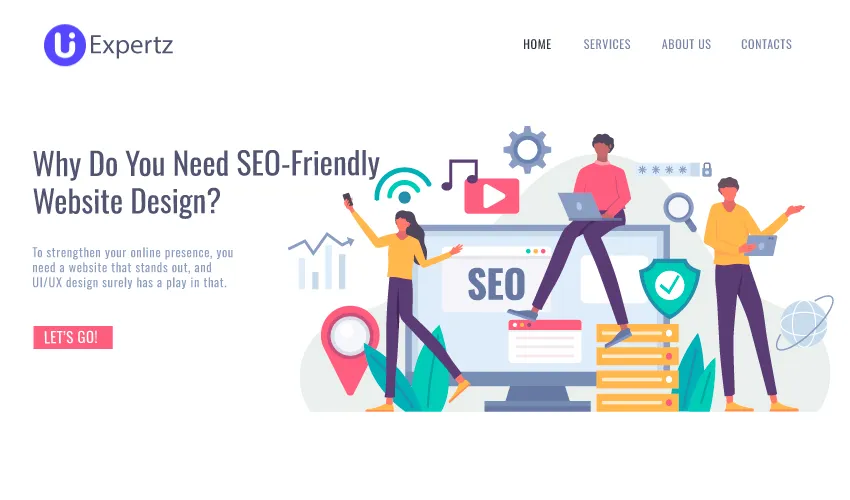In today’s highly competitive digital landscape, creating a visually appealing website is just the first step.
To really succeed, the website needs to be discoverable, engaging, and capable of converting visitors. And that’s where SEO website design comes into the scene.
It refers to designing a website according to search engine optimization principles so that you can leave a presence or make an impression on search engines.
Whatever it is, if you’re really wondering what is SEO website design? What’s the need for that? And how can you make the website SEO-friendly?
This guide is all you need. Check it out!
What Is SEO Website Design and Why Do You Need It?
To strengthen your online presence, you need a website that stands out, and UX/UI design surely has a play in that.

But that’s not enough, to become discoverable on the web, you need to make the website design SEO-friendly, even if that requires a complete website redesign.
Trust me, it’s worth the effort.
Here are a few reasons you need SEO-friendly website design –
- Improved visibility in search engines
- Increased organic traffic
- Better user experience
- Higher conversion rate
- Long-term sustainability
- Competitive advantage
- Cost-effective marketing
- Becoming reliable and trustworthy
How to Build SEO Friendly Website? – 8 Proven Tactics
There are hundreds of ways to make a website SEO-friendly. But if you are new, you shouldn’t try to figure it out all at once. Otherwise, you’ll drown in the depth of optimization knowledge bases.
To make it easier for you, here we’ve come up with a list of 8 proven ways that will definitely help increase your rankings.
1. Following EAT Guidelines
EAT stands for Expertise, Authoritativeness, and Trustworthiness. It’s a concept introduced by Google to assess a website’s content quality to make sure the user gets exactly what they need.
Incorporating EAT can boost your website’s visibility and credibility effectively. Here is how you can implement EAT on your websites.
Expertise
It refers to the level of knowledge and skill that the content creator or the author of the website possesses.
In order to rank a website higher on the SERP (Search Engine Result Page), the search engine (Google) looks for the expertise of the author on the niche. They do it by checking the accuracy, comprehensiveness, uniqueness, and qualifications of the authors.
So, the goal here is to demonstrate the expertise of the field on the website. How can you achieve that?
Highlight the credentials and qualifications of the author or the content creators. For example, if you’re in the health niche, having a certified doctor or physician as an author or content creator will increase the SERP ranking.
Make sure to add the certification at the end of the content and also in the ‘About Us’ section.
Generate information that is accurate, well-researched, up-to-date, comprehensive, and insightful. There is no space for wrong information, it’ll lower the website’s rank on search engines.
Also, try your level best to provide something unique, something that’s not covered on other websites. This will show search engines that you’ve expertise in your niche and that it’s safe for visitors to go through the content. Resulting in higher rankings.
Authoritativeness
Addressing all the queries accurately in a single niche can increase the website’s authority, which can give a huge boost to SERP rankings. Acquire backlinks from high-authoritative websites in your niche, this works like a charm.
But make sure to prioritize quality over quantity. A bunch of quality backlinks from quality websites will work better than thousands of low-quality links.
Add any certifications, awards, or recognitions that the authors have received from the same industry, this will also increase the website’s authority.
Trustworthiness
To make the search engine and the visitors believe in your website, you need to stay transparent.
Transparency can be achieved by displaying updated contact information, such as the location, emails, phone numbers, membership of any organization related to the industry, etc.
Clearly state the website’s privacy policy, terms of use, how the information on the website is collected, and the cross-checking process. And most importantly, make sure to use citations and references for the content published on the website.
Also, maintain a social media presence and stay consistent on the branding, this will help you gain the trust of the user.
Building E-A-T isn’t a one-time thing, it’s a continuous process. You’ve to always keep things updated.
2. Mobile-Friendly Design
According to some surveys, more than 55% of website visitors come from mobile devices. Also, over 92.3% of internet users access the internet through mobile phones.
Therefore, if your website isn’t mobile-friendly, consider redesigning the website, otherwise, you’ll miss out big times.
To make your website mobile-friendly, make the website design responsive so that the website automatically adapts to different screen sizes. Here is a list of major factors that increases the mobile-friendliness –
- Keep the paragraphs short.
- Use easy-to-read fonts and also keep size appropriate (14 – 16px for the body section).
- Highlight the hooking keywords.
- Get rid of intrusive pop-ups.
- Turn the website into a mobile app.
3. Optimize the Loading Speed
The loading time of the website, in most cases works as a determinant of whether a visitor will stay on the website or not.
And the number of people going off the website is known as the ‘Bounce Rate’. Higher loading times will increase the bounce rate.
Therefore, optimizing the loading speed is vital for every website. The ideal loading time for websites is 1 – 3 seconds, anything more than that will be considered slow.
Here are a few ways to increase the loading speed of a website –
- Use lightweight image formats such as Webp. This format reduces the image size by around 34%.
- Choose a fast website hosting.
- Reduce the usage of plugins as much as possible.
- Lower the HTTP requests.
- Enable browser caching.
4. Adding Social Proof to the Website
Social proof on the website increases the credibility and authority of the website. And this can significantly increase the search engine rankings.
Here is how you can effectively integrate social proof to boost the website’s ranking-
- Display a selection of positive user reviews directly on your website’s relevant pages.
- Feature testimonials from several satisfied users to your website, try to add their name, photo, and profession.
- Add social sharing buttons on the content so that users can easily share the content on different platforms.
- If your business has gained any award or recognition from a similar industry, display that.
- Collaborate with influencers who have a strong online presence, their endorsement will increase reliability.
- Engage with both positive and negative user reviews.
5. Internal Linking
This basically refers to connecting different pages on your website. Internal linking is an integral part of a website’s structure. A proper internal linking strategy will give the user a better experience as it will show them a clear path to whatever they need.
For example, a visitor interested in learning how to raise chicken properly might also be interested in learning what food to feed them or what vitamins they require additionally for better growth.
If these contents are linked with one another, visitors will read more. As a result, the bounce rate will be lower, which will boost the SERP rankings.
Not only that, internal linking also helps search engines understand what the pages on your website are about.
Plus, search engines can also know about the most important pages of your sites since those pages usually have a high number of links pointing at them.
6. Optimizing for Rich Snippet
A rich result or rich snippet is an improved search result that provides the user with information that’s visually appealing. And this is a way to hook in visitors.
The rich snippet allows the user to know what the page will offer without even clicking on the title. So, this is the spot that should be optimized properly. Craft it with keywords that will attract the user to read more.
Rich snippets can be optimized using structure data markup on the webpages, which will provide search engines with specific information about the content.
There are different types of rich snippets, such as reviews, recipes, events, products, videos, FAQs, how-to’s, etc.
7. Improve Crawlability and Indexability
Search engine bots crawl through web pages to understand them and index the pages.
And if for any reason, your website doesn’t allow the bots to crawl, no matter how well you optimize the website, it won’t even exist in search engines.
Here are some steps you can take to improve the crawlability and indexability of your website –
- Generate an XML sitemap and then submit that to search engines.
- Use a Robot.txt file to control which pages the search engines shouldn’t crawl.
- Create user-friendly URLs that include the focus keyword.
- Avoid posting duplicate content on the website.
- Use structured data markup to help the search engines know your content.
8. Filling Website’s Metadata
This is also known as a meta tag; these are snippets of text that give a glimpse of the webpage’s content. Though metadata doesn’t directly influence the SERP rankings, it does improve the CTR (click-through rate).
There are several types of metadata that serve different purposes, such as –
- Meta Title
- Meta Description
- Meta Keywords
- Meta Robots Tag
- Canonical Tag
Make sure to fill these metadata with something that will make the user crave more of the content.
Conclusion
If you really want to have a strong online presence, designing your website following the SEO principles is a must, there is no way around it.
And if you’ve read the guide, now you definitely know what is SEO website design and how you can do it.
Apart from the mentioned one, there are a dozen more that can help the SERP rankings, but these are some of the major ones.
FAQs
1. What is an SEO-friendly URL structure?
Ans. The URL should be short, and it should include the focus keyword. For example, website.com/what-does-SEO-friendly-mean.
2. What is the best domain length for SEO?
Ans. If the goal is to become a brand, then keeping the domain short, simple, and memorable would be best. The recommended length is under 15 characters.
3. How many SEO keywords per page?
Ans. There is no set number, as long as the keywords are extremely related to the content, any number of keywords can be targeted.



